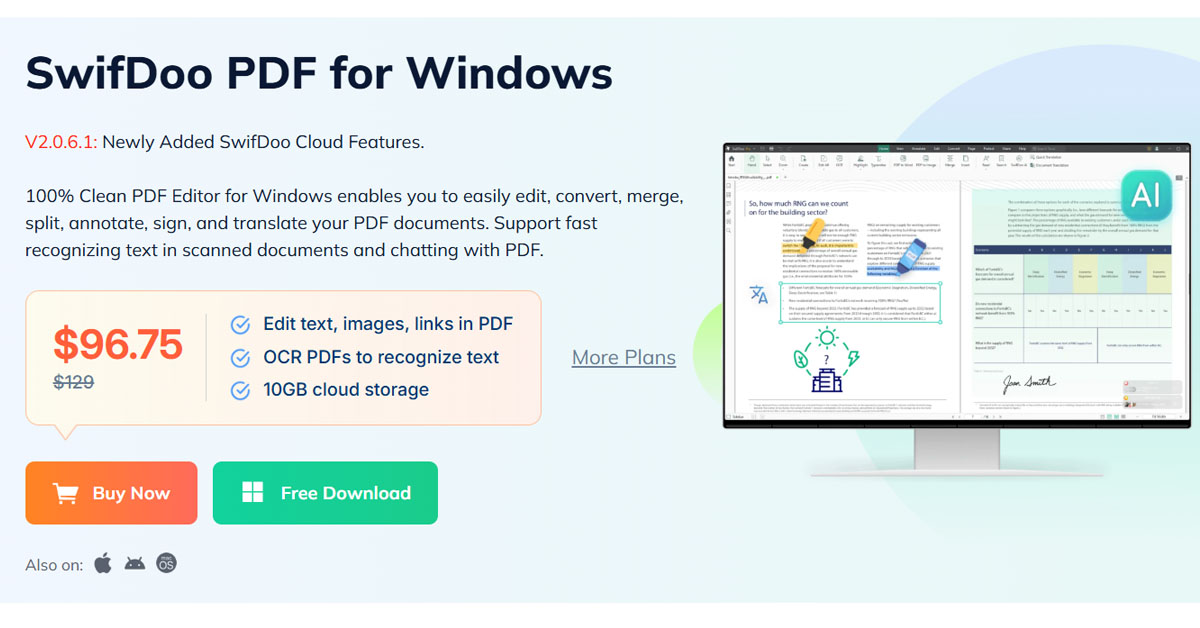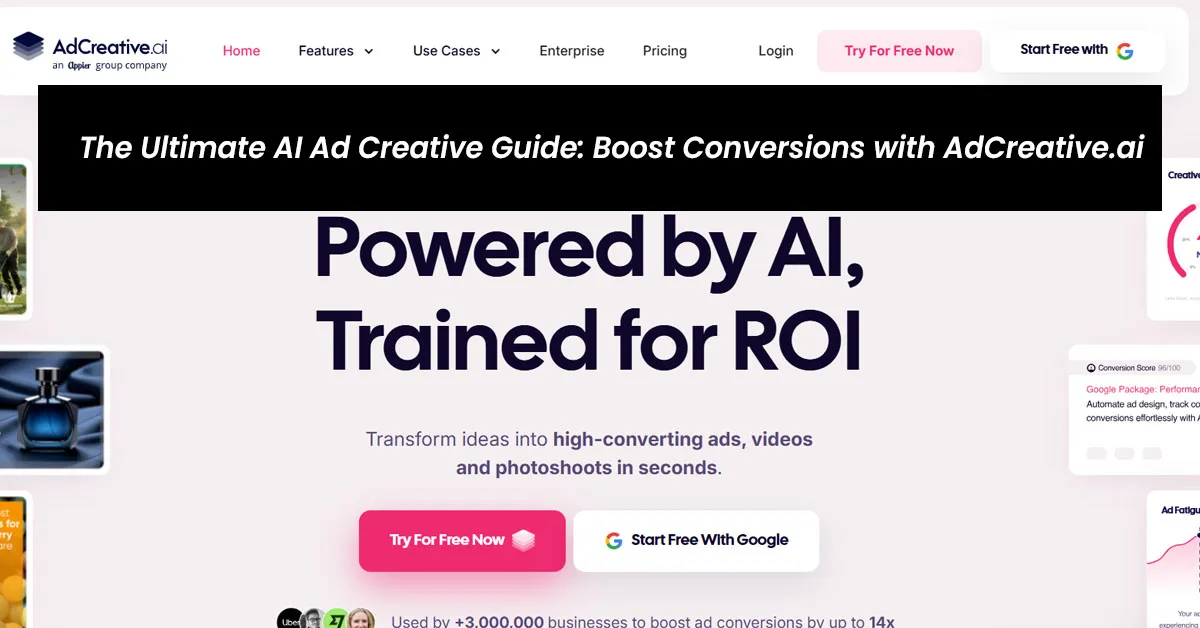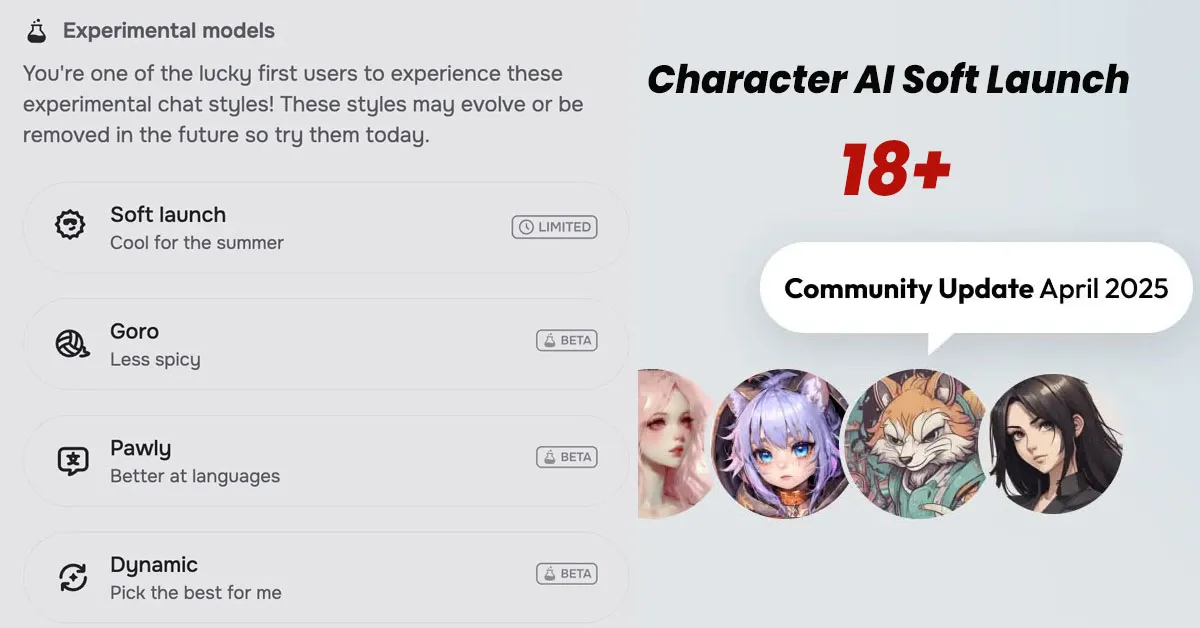
Best AI Tools for Office Productivity (2025) – Copilot vs Duet AI vs Slack GPT
The office software landscape is undergoing a revolution with built-in generative AI. Tech giants Microsoft, Google, and Salesforce (via Slack) have all launched AI “co-pilots” to supercharge productivity. Microsoft 365 Copilot, Google Workspace Duet AI, and Slack GPT aim to automate routine tasks – drafting documents and emails, generating reports, summarizing chats and meetings, and more – directly inside familiar apps. These tools draw on large language models (LLMs) to understand context and generate content in natural language. In practice, each AI assistant has unique strengths aligned with its platform. Below we compare their features, pricing, and use cases, and show how businesses in the US, UK, and Canada can leverage them effectively.
Microsoft 365 Copilot: AI for Microsoft Office
Microsoft 365 Copilot is like having a smart assistant built right into your favorite Office apps — Word, Excel, PowerPoint, Outlook, and Teams. It uses AI to help you get things done faster. Need to turn meeting notes into a proposal? Just ask. Want to build a presentation with images that actually fit your content? It can do that too. It’ll even help clear out your inbox by summarizing long email threads.
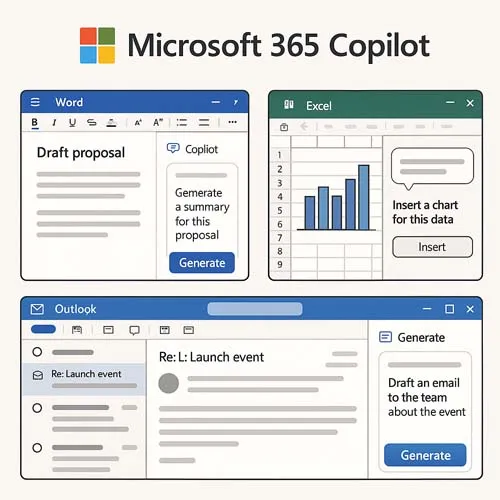
(Image : AI- Generated)
In Excel, Copilot can look at your data, spot trends, and explain what’s going on in plain English — no complicated formulas required. It’s also handy in Teams, where it can pull out key points from meeting transcripts and suggest what to do next.
- Key features: Drafting and rephrasing text in Word and Outlook; generating slides in PowerPoint; analyzing data in Excel; summarizing email and chat threads in Outlook and Teams.
- Integration: Tightly integrated with Microsoft 365 apps (Word/Excel/PowerPoint/Teams). Copilot accesses users’ data in OneDrive and Exchange through Microsoft Graph, enabling context-aware suggestions.
- Pricing: Available to enterprise customers at $30 per user per month on top of existing 365 licenses. Notably, Microsoft requires a 300-seat minimum commitment (≈$9,000/month) for Copilot – a cost barrier for small teams
Bottom line: If your organization runs on Microsoft 365 (Office 365), Copilot brings AI deep into Word, Excel, PowerPoint, Outlook and Teams. It excels at tasks like drafting documents from minimal input, automated note-taking, and data analysis. Be aware of the seat minimum and added cost, but consider piloting it to automate “busy work” and let your team focus on creative or high-value tasks.
Google Workspace Duet AI: AI for G Suite
Google’s answer is Duet AI for Workspace, a generative AI assistant built into Gmail, Docs, Sheets, Slides, Chat, and Meet. After a May 2023 preview, Duet AI is now widely available. It is designed to make routine tasks faster across Google Workspace. For example, in Google Docs a “Help me write” button can draft a full article or email from a brief prompt and even adjust tone or style as desired. In Google Sheets, Duet can auto-generate a spreadsheet structure from a simple description and let you refine it with natural-language edits (e.g. “add a column for revenue”). In Google Slides, Duet can summarize a long document into key bullet points and generate slide content, including AI-created illustrations, which users can further customize. It even offers grammar and style suggestions (like making text more formal or concise). In Gmail on mobile, Duet AI automatically suggests email subjects and replies, as well as categorizing key messages. And in Google Meet, Duet AI can generate meeting summaries and action items, plus even create custom virtual backgrounds from text prompts.
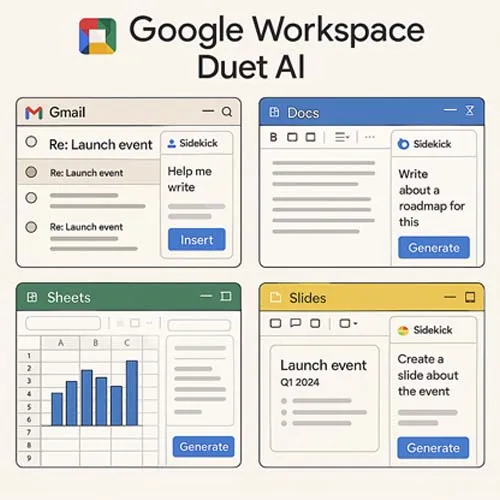
(Image : AI- Generated)
- Key features: AI-assisted writing in Docs, Gmail and Chat; automated Slides and Sheets creation; smart inbox management and email response suggestions; meeting summaries and note-taking in Meet.
- Integration: Built into Google Workspace apps via the new “Sidekick” AI sidebar. It pulls from Workspace data (Docs, Drive, etc.) when crafting content. For instance, Duet can answer questions about data in a sheet linked in an email using the sidebar in Gmail.
- Availability: Duet AI generally costs the same as Copilot ($30 per user/month on top of Workspace subscriptions), but Google also offers a trial period. Unlike Copilot’s hard seat limit, Duet can be enabled for any Google Workspace admin to roll out more flexibly.
Duet’s strength is in personal productivity and collaboration. It focuses on generating content and insights for individual users, complementing Gmail and Chat workflows. For example, it can rephrase your draft email in a friendlier tone or create a draft blog post outline from bullet points. Google also promises advanced AI image generation in Slides. Importantly, Duet works across devices – even on mobile – so you can ask a question or draft a reply on the go.
Bottom line: If your organization relies on Google Workspace (Gmail, Docs, Sheets, etc.), Duet AI can automate creative and data tasks without leaving those apps. It’s ideal for teams wanting quick AI-generated content (like draft emails or slide decks) and automated data organization. Since it’s part of Workspace, rollout is straightforward for Google-centric environments.
Slack GPT: AI for Chat and Collaboration
Slack GPT (announced by Salesforce in 2023) brings generative AI natively into Slack’s collaboration platform. Unlike Copilot/Duet, Slack GPT is focused on conversational workflows. It can generate AI-powered responses, summaries, and content directly inside Slack channels and huddles. For example, a user returning to a busy channel can click “summarize” to get an overview of all recent discussions, skipping the need to manually read dozens of messages. Slack GPT can also take transcriptions from Slack Huddles (voice calls) and generate concise meeting notes. Additionally, it adds an AI “Canvas” tool where Slack users can create rich documents; Slack GPT can automatically populate a Canvas with project details, links to files, and even relevant profile cards of team members.
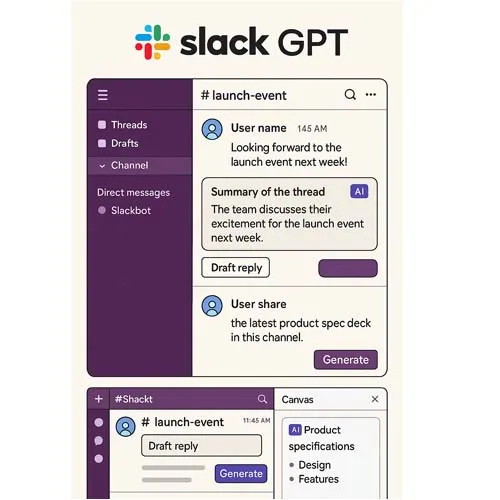
(Image : AI- Generated)
- Key features: Automated conversation summaries; AI-assisted message writing (e.g. draft a reply or rephrase a message); AI-powered Canvas documents; integration with Slack Workflow Builder for automated tasks like lead follow-ups.
- Integration: Deeply integrated into Slack’s interface. Users will see options (such as an “AI” button) in channels and huddles for actions like “Summarize thread” or “Generate reply.” Slack GPT also connects to Salesforce Einstein GPT: for instance, you can ask Slack (via Einstein) for customer or campaign data from Salesforce’s CRM and get answers inside Slack. Slack GPT supports multiple LLMs (OpenAI GPT, Anthropic Claude, and Salesforce’s future model) behind the scenes.
- Availability: As of 2024, Slack GPT features are in development and rolling out to enterprise customers. Pricing details haven’t been fully announced, but they will likely be part of Slack’s (or Salesforce’s) enterprise plans. No per-seat fee or seat minimum has been publicized yet.
Salesforce touts Slack GPT as a “conversational AI experience” for the enterprise. Its focus is making Slack itself smarter. Instead of leaving Slack to use external AI tools, teams can handle creative tasks right in chat. For example, marketing could generate draft social posts from a brief prompt in Slack, or support teams could auto-summarize customer tickets shared in a channel. Notably, Slack GPT emphasizes security and compliance: admins can control data access and approve which LLMs apps can use.
Bottom line: Slack GPT is best for teams that live in Slack. It adds AI without leaving your chat environment – summarizing threads, drafting messages, and automating workflows. Because it taps into all your Slack archives and Salesforce data, it can provide contextual answers about your projects or customers in seconds. If you’re already using Slack (especially with Salesforce), Slack GPT will feel like a natural assistant inside your channels.
Comparing the AI Assistants Copilot vs Duet AI vs Slack GPT
The three tools have overlapping goals but different strengths. The table below highlights key differences:
Capability |
Microsoft 365 Copilot |
Google Duet AI |
Slack GPT |
|---|---|---|---|
| Platform | Microsoft 365 (Office 365 apps on Windows/Mac/iOS/Android) | Google Workspace (Gmail, Docs, Sheets, Slides, Chat, Meet) | Slack (desktop, web, mobile; part of Salesforce) |
| Core focus | Office documents, email, meetings | Documents, spreadsheets, email drafts | Chat conversations and workflows |
| Text generation | Drafts documents in Word/OneNote; rewrites emails in Outlook; generates PowerPoint decks | Drafts Docs, Gmail replies, Chat messages; creates Sheets templates | Suggests replies or messages; populates Canvas documents |
| Email and messaging | Summarizes/prioritizes Outlook email and Teams chats | Summarizes Gmail threads with “Sidekick” sidebar; suggests email replies | Summarizes Slack channels and Huddle (voice) threads |
| Meetings | Generates meeting agendas and summaries from Teams transcripts | Generates meeting summaries and action items for Google Meet | Transcribes Huddles; summarizing conversations on Slack |
| Docs/Presentations | Creates Word documents from prompts; generates full PowerPoint slides with images | Creates Docs from prompts; generates Slides (with AI images) and speaker notes | AI-assisted Canvas creation (documents, wikis) |
| Spreadsheets | Analyzes Excel data, identifies trends and explains calculations | Generates Sheets from prompts; auto-labels and categorizes data | (Integration possible via Salesforce data tools) |
| Languages supported | Supports many languages (English US/UK/CA, Spanish, French, etc.) | Supports major languages via Google’s AI (English, etc.) | English-based prompts (LLM dependent) |
| Pricing (enterprise) | $30/user/month on top of 365 licenses (300-user minimum) | $30/user/month on top of Workspace (trial available) | To be announced (likely enterprise plans) |
This comparison shows that Copilot is strongest within classic office productivity (Office docs, email, meetings), Duet excels at content creation inside Google’s apps (writing, data work, slide creation), and Slack GPT specializes in chat-driven tasks and summarization. In many cases you’ll use more than one: for example, a team might draft a report in Word using Copilot, create data charts in Sheets with Duet, and discuss results in Slack with GPT summing up the conversation.
Getting Started: Simple Ways to Use AI Office Assistants Effectively
Getting started with tools like Microsoft Copilot, Google Duet AI, and Slack GPT doesn’t have to be complicated. Here’s how you can ease into using them and get the most value—right from day one.
1. Make Sure You're Set Up
Before diving in, check whether your organization’s current plan supports these tools:
- Microsoft Copilot is available with Microsoft 365 E3/E5 licenses, but it does require a minimum of 300 users. It’s best suited for larger teams.
- Google Duet AI can be added to Google Workspace Enterprise plans and is often available with a free trial.
- Slack GPT is gradually rolling out to paid Slack plans, especially those already integrated with Salesforce.
If you're unsure, ask your IT admin or review your workspace settings to confirm eligibility.
2. Start with Small, Simple Tasks
These AI tools work best when you ease into them. Try short prompts like:
- In Copilot: “Write a follow-up email to [client name] about the proposal.”
- In Duet AI: “Create a marketing budget table in Sheets.”
- In Slack GPT: “Summarize the conversation in this channel.”
Once you're comfortable, try longer, more layered requests like generating a full report or building out a presentation.
3. Talk to AI Like a Teammate
The beauty of these assistants is that they understand everyday language. You don’t need to speak in commands—just ask naturally:
- “Turn these bullet points into a formal paragraph.”
- “Summarize yesterday’s meeting notes.”
- “Find trends in this revenue data and visualize them.”
They’re designed to help you work faster, not replace you—so don’t hesitate to tweak or guide their output.
4. Keep Privacy Top of Mind
AI assistants handle a lot of information, some of which might be sensitive. Here’s what to know:
- Copilot uses your internal company data (via Microsoft Graph), so its suggestions are tailored but stay within your system.
- Slack GPT honors existing workspace permissions and gives admins control over which models are used and what data is accessed.
As a best practice, always double-check outputs—especially if they involve legal, financial, or HR-related information.
5. Teach Your Team the Basics
AI productivity tools are most effective when everyone knows how to use them. Consider hosting a quick team session or sharing a cheat sheet with example prompts like:
- In Gmail: Click the Duet (Sidekick) icon to draft or reword messages.
- In Slack: Use
/summarizeto quickly get the gist of a long conversation.
Even a little training goes a long way. When everyone understands how to use the tools, collaboration becomes faster and more focused.
These AI assistants represent the latest wave of productivity tools. By understanding their features and use cases, you can integrate them effectively and let your teams focus on creativity and strategic work, leaving the busywork to AI.
Sources: Top tech publications and vendor announcements for Microsoft Copilot, Google Duet AI, and Slack GPT were analyzed to ensure accuracy (TechRadar, ITPro, UpCurve Cloud, etc.)
It’s an AI assistant integrated into Microsoft Office apps. Copilot uses GPT-4 to help you write documents, analyze Excel data, create presentations, and summarize Outlook/Teams content.
Duet AI is Google Workspace’s built-in AI helper. It can draft emails and docs, generate Sheets and Slides from prompts, improve text with style suggestions, and even summarize Meet recordings. Think of it as an AI sidekick in Gmail, Docs, Sheets and Chat.
Slack GPT injects AI right into your Slack chats. It summarizes long conversations, drafts or rewrites messages, and auto-generates content on Canvas or in workflows. It’s geared toward real-time collaboration, whereas Copilot/Duet are built for traditional office apps.
Both Copilot and Duet AI are enterprise add-ons at $30 per user/month (on top of your Office 365 or Google Workspace subscription). Microsoft requires a 300-user minimum (≈$9K/month) for Copilot. Slack GPT pricing has not been finalized publicly but will likely be included in Slack’s enterprise plans.
It depends on your ecosystem. If your organization is invested in Microsoft 365, Copilot will integrate seamlessly. If you live in Google apps, Duet AI makes sense. If your team collaborates mostly on Slack (especially with Salesforce CRM), then Slack GPT is ideal. In many modern workplaces, you might use two or all three. Each addresses different user intents: email and document drafting (Copilot, Duet) vs. chat and workflow automation (Slack GPT).
Microsoft has run previews of Copilot and may offer trials via 365 programs. Google often provides trials of Workspace add-ons like Duet. Slack GPT features are rolling out in limited betas and trials for enterprise customers. Keep an eye on Microsoft 365 and Google Workspace blogs for trial announcements, and join Salesforce’s Slack developer program for early access.


